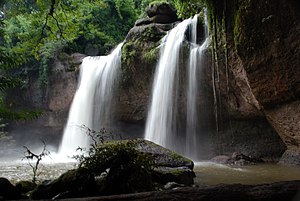
National parks in Thailand (Thai: อุทยานแห่งชาติ) are defined as areas that contain "natural resources of ecological importance or unique beauty, or flora and fauna of special importance". As of 2019[update] Thailand's protected areas included 156 national parks, 58 wildlife sanctuaries, 67 non-hunting areas, and 120 forest parks. They cover almost 31 percent of the kingdom's territory.[1]
The parks are administered by the National Parks, Wildlife and Plant Conservation Department (DNP), of the Ministry of Natural Resources and Environment (MNRE). The department was created in 2002, and took over the national parks from the Royal Forest Department of the Ministry of Agriculture.[2]
The first national park was Khao Yai in 1961, when the National Park Act B.E. 2504 was passed. The first marine park was Khao Sam Roi Yot, established in 1966. In 1993 the administration of the national parks was split into two divisions, one for the terrestrial and one for the Marine National Park Division (MNPD).[3]
Controversies about Thailand's national parks include complaints over excessive development and allotment of private concessions. Ko Samet, and other island-based national parks, are particularly impacted by the activities of private concessions, often in the form of excessive bungalow developments. Many of the northern parks are greatly impacted by illegal swidden farming and poaching.